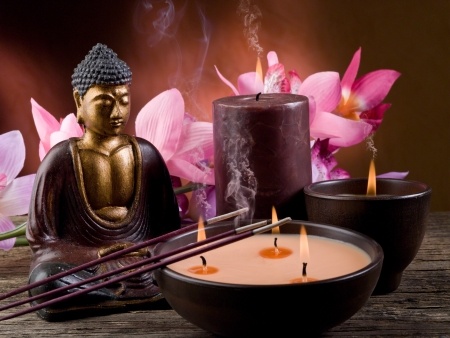First find a private place to sit quietly, where you’re least likely to be interrupted. (I’ve used the bathroom floor, the backseat of my car, my bed, a cave at the beach, a rock on a quiet trail.) Then find a pillow or chair to sit on. You’ll need a digital timer (you can use a kitchen timer or the one on your phone, but turn off your wireless so you aren’t tempted to check messages when the going gets tough.)

- Sit cross-legged or comfortably on your chair or pillow.
- Set your timer for eleven minutes (twenty-two if you can spare them). You can always work up to more time. Doing this daily is ideal and most effective, even if five minutes is all you have.
- Close your eyes and breathe deeply in and out through your nose. Be aware of the breath entering and leaving your nostrils. Focus on the sensation of the skin just under your nose as the breath enters and leaves your nostrils. Focus. Each time your mind wanders, gently return it to the sensation of your breath entering and leaving your nose. One of my mentors says that when your mind wanders, it’s like a kitten escaping a box – no need to get mad at the kitten, just gently put it back in the box.
- Take your focus from the area under your nose and scan your body, from your head down to your toes. Start with the top of your head and methodically go into each muscle of your face, neck, shoulders, arms, hands, chest, back, solar plexus, abdomen, hips, thighs, knees, calves, ankles, feet and toes. Notice any sensation in any part of your body but do not linger in any one spot. See the sensation, observe it without judging it, and then keep scanning. Observe each sensation of your body as if you are a nurse observing a patient – no judgment, just quiet observation, acceptance, and then on to the next part of the body.
- Reverse your scan: starting at your toes, move up through your feet, ankles, calves, knees, thighs, hips, abdomen, solar plexus, back, chest, hands, arms, shoulders, neck, chin, mouth, cheeks, nose, eyes, forehead, and up to the top of the head.
- Repeat steps 4 and 5. Whenever a sensation comes up, observe and name it in your mind. Whenever an emotion comes up, observe and name it in your mind. If your knee hurts, simply name it “pain”; if you’re worrying, name is “worrying.” And keep going, naming each sensation without attaching to it. The key is to maintain your momentum through the scanning and observing.
- When the timer goes off, take one final deep breath and release it slowly. Bring your attention back to your heart and visualize your heart opening up; see a bright light glowing there.
Doing this practice consistently peels away the layers of reactions we automatically engage in when fear and pain arise. By observing, naming, and moving on, you begin to see pain and pleasure as impermanent sensations. By observing them without glomming on to the story, by not becoming attached to them, you liberate yourself from running toward pleasure or away from pain and are free to stand fully in the face of your entire life. You are free to become lighter, happier, and more spacious. The power that pain has over you will slowly diminish, giving way to new possibilities in your body and mind. What is left is more of you, accessible and present to your beautiful life and all the joy it generously brings.
The secret of health for both mind and body is not to mourn for the past, nor to worry about the future, but to live the present moment wisely and earnestly.
BUDDAH